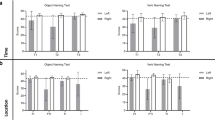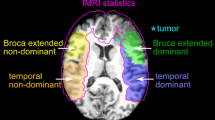Abstract
We have previously revealed that identification of the frontal language area (FLA) can be difficult in patients with dominant frontal glioma involving the pars triangularis (PT). The present study added new cases and performed additional analyses. We noticed a new finding that the presence of extension to the pars orbitalis (POr) was associated with negative response to the FLA. The aim of the present study was to evaluate the impact of PT involvement with extension to the POr on the failure to identify the FLA. From 2000 to 2017, awake craniotomy was performed on 470 patients. Of these patients, the present study included 148 consecutive patients with frontal glioma on the dominant side. We evaluated whether tumors involved the PT or extended to the POr. Thirty one of 148 patients showed involvement of the PT, and we examined the detailed characteristics of these 31 patients. The rate of negative response for the FLA was 61% in patients with involvement of the PT. In 31 patients with frontal glioma involving the PT, univariate analyses showed significant correlation between extension to the POr and failure to identify the FLA (P = 0.0070). Similarly, multivariate analysis showed only extension to the POr correlated significantly with failure to identify the FLA (P = 0.0129). We found new evidence that extension to the POr which impacts connectivity between the PT and POr correlated significantly with negative response to the FLA of patients with dominant frontal glioma.



Similar content being viewed by others
References
Ardila A, Bernal B, Rosselli M (2016) How localized are language brain areas? A review of Brodmann areas involvement in oral language. Archives of Clinical Neuropsychology: the Official Journal of the National Academy of Neuropsychologists 31:112–122. https://doi.org/10.1093/arclin/acv081
Ardila A, Bernal B, Rosselli M (2017) Should Broca's area include Brodmann area 47? Psicothema 29:73–77. https://doi.org/10.7334/psicothema2016.11
Catani M, Jones DK, ffytche DH (2005) Perisylvian language networks of the human brain. Ann Neurol 57:8–16. https://doi.org/10.1002/ana.20319
Damasio AR, Geschwind N (1984) The neural basis of language. Annu Rev Neurosci 7:127–147. https://doi.org/10.1146/annurev.ne.07.030184.001015
Duffau H (2005) Lessons from brain mapping in surgery for low-grade glioma: insights into associations between tumour and brain plasticity. Lancet Neurol 4:476–486. https://doi.org/10.1016/S1474-4422(05)70140-X
Duffau H (2007) Contribution of cortical and subcortical electrostimulation in brain glioma surgery: methodological and functional considerations. Neurophysiologie Clinique = Clinical Neurophysiology 37:373–382. https://doi.org/10.1016/j.neucli.2007.09.003
Duffau H (2014) The huge plastic potential of adult brain and the role of connectomics: new insights provided by serial mappings in glioma surgery. Cortex: J Devoted to the Study of the Nervous System and Behavior 58:325–337. https://doi.org/10.1016/j.cortex.2013.08.005
Egger J, Kapur T, Fedorov A, Pieper S, Miller JV, Veeraraghavan H, Freisleben B, Golby AJ, Nimsky C, Kikinis R (2013) GBM volumetry using the 3D slicer medical image computing platform. Sci Rep 3:1364. https://doi.org/10.1038/srep01364
Foundas AL, Eure KF, Luevano LF, Weinberger DR (1998) MRI asymmetries of Broca's area: the pars triangularis and pars opercularis. Brain Lang 64:282–296. https://doi.org/10.1006/brln.1998.1974
Foundas AL, Leonard CM, Gilmore RL, Fennell EB, Heilman KM (1996) Pars triangularis asymmetry and language dominance. Proc Natl Acad Sci U S A 93:719–722
Foundas AL, Leonard CM, Heilman KM (1995) Morphologic cerebral asymmetries and handedness. The pars triangularis and planum temporale. Arch Neurol 52:501–508
Friederici AD (2015) White-matter pathways for speech and language processing. Handb Clin Neurol 129:177–186. https://doi.org/10.1016/B978-0-444-62630-1.00010-X
Giussani C, Roux FE, Ojemann J, Sganzerla EP, Pirillo D, Papagno C (2010) Is preoperative functional magnetic resonance imaging reliable for language areas mapping in brain tumor surgery? Review of language functional magnetic resonance imaging and direct cortical stimulation correlation studies. Neurosurgery 66:113–120. https://doi.org/10.1227/01.NEU.0000360392.15450.C9
Kayama T, Guidelines Committee of the Japan Awake Surgery C (2012) The guidelines for awake craniotomy guidelines committee of the Japan Awake Surgery conference. Neurol Med Chir 52:119–141
Kim SS, McCutcheon IE, Suki D, Weinberg JS, Sawaya R, Lang FF, Ferson D, Heimberger AB, DeMonte F, Prabhu SS (2009) Awake craniotomy for brain tumors near eloquent cortex: correlation of intraoperative cortical mapping with neurological outcomes in 309 consecutive patients. Neurosurgery 64:836–845; discussion 345-836. https://doi.org/10.1227/01.NEU.0000342405.80881.81
Lemaire JJ, Golby A, Wells WM 3rd, Pujol S, Tie Y, Rigolo L, Yarmarkovich A, Pieper S, Westin CF, Jolesz F, Kikinis R (2013) Extended Broca's area in the functional connectome of language in adults: combined cortical and subcortical single-subject analysis using fMRI and DTI tractography. Brain Topogr 26:428–441. https://doi.org/10.1007/s10548-012-0257-7
Louis DN, Ohgaki H, Wiestler OD, Cavenee WK, Burger PC, Jouvet A, Scheithauer BW, Kleihues P (2007) The 2007 WHO classification of tumours of the central nervous system. Acta Neuropathol 114:97–109. https://doi.org/10.1007/s00401-007-0243-4
Muragaki Y, Iseki H, Maruyama T, Kawamata T, Yamane F, Nakamura R, Kubo O, Takakura K, Hori T (2006) Usefulness of intraoperative magnetic resonance imaging for glioma surgery. Acta Neurochir Suppl 98:67–75
Muragaki Y, Iseki H, Maruyama T, Tanaka M, Shinohara C, Suzuki T, Yoshimitsu K, Ikuta S, Hayashi M, Chernov M, Hori T, Okada Y, Takakura K (2011) Information-guided surgical management of gliomas using low-field-strength intraoperative MRI. Acta Neurochir Suppl 109:67–72. https://doi.org/10.1007/978-3-211-99651-5_11
Nossek E, Matot I, Shahar T, Barzilai O, Rapoport Y, Gonen T, Sela G, Korn A, Hayat D, Ram Z (2013) Failed awake craniotomy: a retrospective analysis in 424 patients undergoing craniotomy for brain tumor. J Neurosurg 118:243–249. https://doi.org/10.3171/2012.10.JNS12511
Peraud A, Ilmberger J, Reulen HJ (2004) Surgical resection of gliomas WHO grade II and III located in the opercular region. Acta Neurochir 146:9–17; discussion 17-18. https://doi.org/10.1007/s00701-003-0165-4
Rolston JD, Englot DJ, Benet A, Li J, Cha S, Berger MS (2015) Frontal operculum gliomas: language outcome following resection. J Neurosurg 122:725–734. https://doi.org/10.3171/2014.11.JNS132172
Roux FE, Boulanouar K, Lotterie JA, Mejdoubi M, LeSage JP, Berry I (2003) Language functional magnetic resonance imaging in preoperative assessment of language areas: correlation with direct cortical stimulation. Neurosurgery 52:1335–1345 discussion 1345-1337
Saito T, Muragaki Y, Maruyama T, Tamura M, Nitta M, Tsuzuki S, Konishi Y, Kamata K, Kinno R, Sakai KL, Iseki H, Kawamata T (2016) Difficulty in identification of the frontal language area in patients with dominant frontal gliomas that involve the pars triangularis. J Neurosurg 125:803–811. https://doi.org/10.3171/2015.8.JNS151204
Saito T, Tamura M, Muragaki Y, Maruyama T, Kubota Y, Fukuchi S, Nitta M, Chernov M, Okamoto S, Sugiyama K, Kurisu K, Sakai KL, Okada Y, Iseki H (2014) Intraoperative cortico-cortical evoked potentials for the evaluation of language function during brain tumor resection: initial experience with 13 cases. J Neurosurg 121:827–838. https://doi.org/10.3171/2014.4.JNS131195
Sanai N, Mirzadeh Z, Berger MS (2008) Functional outcome after language mapping for glioma resection. N Engl J Med 358:18–27. https://doi.org/10.1056/NEJMoa067819
Southwell DG, Hervey-Jumper SL, Perry DW, Berger MS (2016) Intraoperative mapping during repeat awake craniotomy reveals the functional plasticity of adult cortex. J Neurosurg 124:1460–1469. https://doi.org/10.3171/2015.5.JNS142833
Szelenyi A, Bello L, Duffau H, Fava E, Feigl GC, Galanda M, Neuloh G, Signorelli F, Sala F, Workgroup for Intraoperative Management in Low-Grade Glioma Surgery Within the European Low-Grade Glioma N (2010) Intraoperative electrical stimulation in awake craniotomy: methodological aspects of current practice. Neurosurg Focus 28:E7. https://doi.org/10.3171/2009.12.FOCUS09237
Tamura M, Muragaki Y, Saito T, Maruyama T, Nitta M, Tsuzuki S, Iseki H, Okada Y (2015) Strategy of surgical resection for glioma based on intraoperative functional mapping and monitoring. Neurol Med Chir 55:383–398. https://doi.org/10.2176/nmc.ra.2014-0415
Yoshimitsu K, Suzuki T, Muragaki Y, Chernov M, Iseki H (2010) Development of modified intraoperative examination monitor for awake surgery (IEMAS) system for awake craniotomy during brain tumor resection. Conference Proceedings 2010:6050–6053. https://doi.org/10.1109/IEMBS.2010.5627616
Acknowledgements
Special thanks are extended to Dr. Takashi Komori, Ms. Soko Ikuta, Satoko Fukuchi, Asuka Komori, and Mr. Takashi Sakayori for valuable help with clinical work and data analysis.
Funding
This study was supported by the Japan Society for the Promotion of Science (JSPS) KAKENHI Grant No. 18K09006.
Author information
Authors and Affiliations
Corresponding author
Ethics declarations
Ethical approval
Ethical approval was obtained from the ethics committee at the Tokyo Women’s Medical University (No. 3540).
Informed consent
Given the retrospective design, the institutional review board waived the requirement for informed consent. We took the opt-out method. To protect patient privacy, we removed all identifiers from our records upon completion of our analyses.
Conflict of interest
The authors declare that they have no potential conflicts of interest.
Rights and permissions
About this article
Cite this article
Saito, T., Muragaki, Y., Tamura, M. et al. Impact of connectivity between the pars triangularis and orbitalis on identifying the frontal language area in patients with dominant frontal gliomas. Neurosurg Rev 43, 537–545 (2020). https://doi.org/10.1007/s10143-018-1052-z
Received:
Revised:
Accepted:
Published:
Issue Date:
DOI: https://doi.org/10.1007/s10143-018-1052-z




